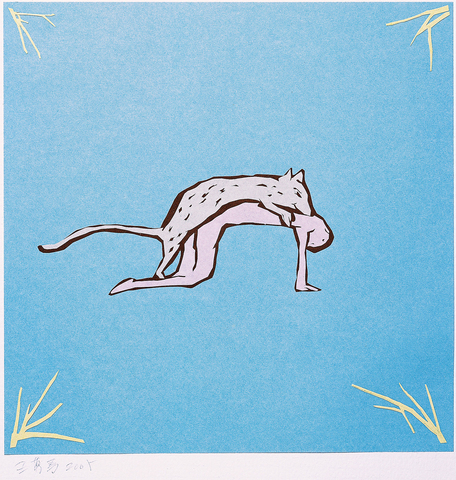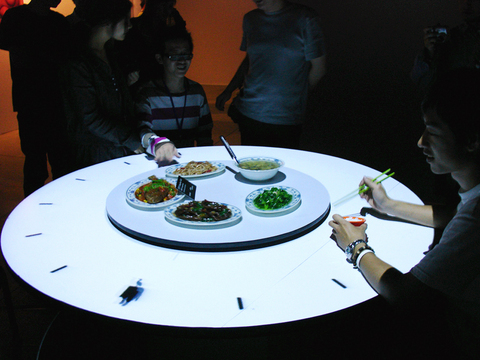Two exhibitions currently on show highlight both old and new art techniques and mediums, yet show that ultimately it is the artists' ideas that wins out. Wang Wan-chun's (王萬春) current show of paper-cut works at the Chi-Wen Gallery contains small, framed pictures that resemble painted Surrealist land-scapes, but were made by cutting quality Japanese paper with knives or scissors, and overlaying colors to create depth and spatial dimension.
Paper cutting is a tradition in Taiwan. Years ago, countryside shamans visited families to fashion paper cut-outs in their likeness, which they painted with a calligraphic brush to further depict their faces. Armed with these symbolic paper figures, the shamans would then chant blessings for the entire family. Legend has it that these shamans remained celibate in order to keep their paper spells potent.
Wang remembers such cultural traditions, often basing his images from well-loved Chinese myths such as the Tales of the Monsters From the Six Dynasties and Strange Tales of Liaozhai, which are ripe with super-natural beings and monsters. His imagery shows vast, nightmarish landscapes of lost wandering souls, decapitated heads, ominous skies, and bestial figures, which he contrasts with the image of a tranquil mountain or a trickling waterfall. Wang is at his best when he focuses on detail. Small, clearly delineated shapes such as a turtle boast finely cut lines; the horizon lines of many of his pictures, on the other hand, are not evenly curved lines -- they virtually quiver and shake with raw emotion.

PHOTO COURTESY OF CHI-WEN GALLERY
After Dark is a group show of graduate students in the digital arts department of the Taipei National University of the Arts (in Guandu) at the Huashan Cultural Center. Seeing the work of young students is thrilling -- like watching a horse race. That is, spectators are often tempted to bet which artists will be in the art world for the long run. Most of the works on view are video-based and require minimum lighting for optimal viewing. It is the hope of many in the nation's art scene to make Taiwan a digital artist's paradise, and as this exhibition demonstrates, local art universities are turning out some talented and technically skilled artists.
Lin Jiun-shian's interactive work asks for the viewer to hold the flame of a lighter to the monitor screen. A heat sensor then triggers a change in the projected images, which allude to the local custom of devotional paper burning.
Kuo Zhong-kuan's (

PHOTO COURTESY OF KUO I-CHEN
Such spiritual voids in technology-based art is exemplified by Chang Po-chih's (
Kuo I-chen (郭奕臣) is definitely an artist to keep an eye on. For him, technology is merely a means to convey his meaning, and is not the be-all and end-all. In the nostalgic Beyond the Liminal Zone, a small sculpture of a house displays the nervously staccato images of the urban scene outside the gallery, which is recorded by six cameras.
Chen Chih-chien's (陳志建 ) projection on a screen suspended above the viewer's head shows sped-up footage of the Ximending area. This is an effective way to communicate that we cannot keep up with the pace of technological development, nor can we arrest time.
Exhibition notes:
What: Wang Wan-chun (王萬春) Spirit of Youth and Passion, Paper-cut art
Where: Chi-Wen Gallery 3F, 19, Ln 252, Dunhua S Rd Sec 1, Taipei (台北市大安區敦化南路一段252巷19號3樓)
Telephone: (02) 8771-3372
When: Tuesday to Saturday, 11:00am to 7:00pm through June 24
What: After Dark, Taipei National University of the Arts graduate students' show
Where: Huashan Cultural Center (華山文化園區), 100 Bade Road Sec 1, Taipei (台北市100八德路一段一號).
On the net: www.aga.org.tw
Telephone: (02) 2321-4808
When: Until May 28

In the March 9 edition of the Taipei Times a piece by Ninon Godefroy ran with the headine “The quiet, gentle rhythm of Taiwan.” It started with the line “Taiwan is a small, humble place. There is no Eiffel Tower, no pyramids — no singular attraction that draws the world’s attention.” I laughed out loud at that. This was out of no disrespect for the author or the piece, which made some interesting analogies and good points about how both Din Tai Fung’s and Taiwan Semiconductor Manufacturing Co’s (TSMC, 台積電) meticulous attention to detail and quality are not quite up to

April 21 to April 27 Hsieh Er’s (謝娥) political fortunes were rising fast after she got out of jail and joined the Chinese Nationalist Party (KMT) in December 1945. Not only did she hold key positions in various committees, she was elected the only woman on the Taipei City Council and headed to Nanjing in 1946 as the sole Taiwanese female representative to the National Constituent Assembly. With the support of first lady Soong May-ling (宋美齡), she started the Taipei Women’s Association and Taiwan Provincial Women’s Association, where she

Chinese Nationalist Party (KMT) Chairman Eric Chu (朱立倫) hatched a bold plan to charge forward and seize the initiative when he held a protest in front of the Taipei City Prosecutors’ Office. Though risky, because illegal, its success would help tackle at least six problems facing both himself and the KMT. What he did not see coming was Taipei Mayor Chiang Wan-an (將萬安) tripping him up out of the gate. In spite of Chu being the most consequential and successful KMT chairman since the early 2010s — arguably saving the party from financial ruin and restoring its electoral viability —

It is one of the more remarkable facts of Taiwan history that it was never occupied or claimed by any of the numerous kingdoms of southern China — Han or otherwise — that lay just across the water from it. None of their brilliant ministers ever discovered that Taiwan was a “core interest” of the state whose annexation was “inevitable.” As Paul Kua notes in an excellent monograph laying out how the Portuguese gave Taiwan the name “Formosa,” the first Europeans to express an interest in occupying Taiwan were the Spanish. Tonio Andrade in his seminal work, How Taiwan Became Chinese,